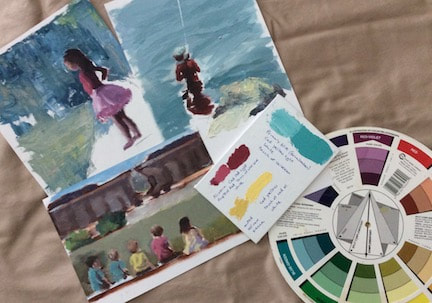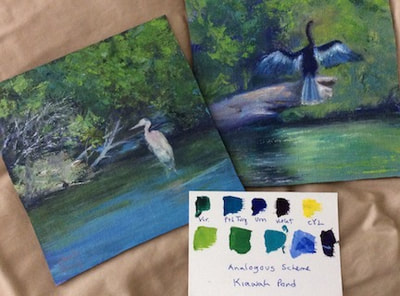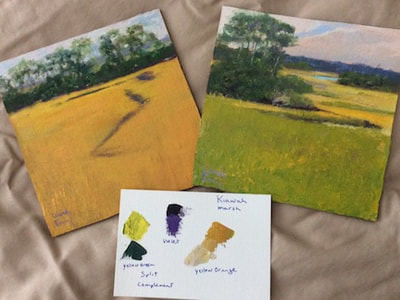|
There is just SO MUCH to learn as an artist! (I am very glad my first instructor (Jo Griffith) did not scare us all away by telling us how far we had to go.) One of the key subjects for a painter is color and early on I found that sticking with a limited palette of warm and cool versions of the three primaries worked best for avoiding color messes. Some people call those messes "mud" but when you have harmonizing colors mud can be quite pretty! Recently, I was introduced to another way to approach color harmony through using "color schemes." If you look on the color wheel there are arrows and shapes and a bunch of words about complimentary, split complementary, triads, and tetrads (insert bug-eyed emoji) and more. Choosing a specific color combination based on one of those harmonies is called a "color scheme." Having a color scheme can be very helpful as a roadmap of sorts, but also as a way of unifying a group of paintings and communicating a specific feeling the artist is hoping to evoke.  This is a series of paintings in the preliminary stage where I'm working out the composition and values on oil painting paper (another awesome new discovery!) I've got my handy dandy color wheel there, as well as my color scheme card. I wanted all three paintings to harmonize with each other because the subject and big idea of each of them is to capture the wonder and fascination of childhood. This is a primary color scheme: blue, red, and yellow...tweaking the hues just a bit to soften and be more pleasing to the eye. Making color scheme cards has really helped me stay on track. After mixing small piles of paint, I put a streak of each on the card and label the painting it's for and what tube colors I used. It's like a recipe card for painting. The tube colors are important because there may be a need for a shadow or subject such as the train in one of the kid paintings that needed to harmonize and can be achieved by using a combination of the same original tube colors. Two more examples are the Kiawah paintings I blogged about earlier. The bird paintings are an analogous scheme, using 5 colors that are next to each other on the wheel. The marsh paintings are a split complementary scheme: a key color and the two colors on either side of its complement. If you want to learn more about color harmony, I found this website helpful.
Thank you for reading my blog!! Comments & questions are treasured!!
0 Comments
Leave a Reply. |
Hello! My name is Wendy and I am passionate about oil painting! Whether in the studio or out in Mother Nature, I get lost in the experience of capturing on canvas the moment and the feel of what I am painting. I pour my love and energy into every single piece of artwork and I hope it shows! This blog is a place where I can use words to talk about art, painting, life, faith, things that make me laugh, and things that inspire. I love every response, so don't be shy about leaving a comment...Archives
June 2024
Categories |

